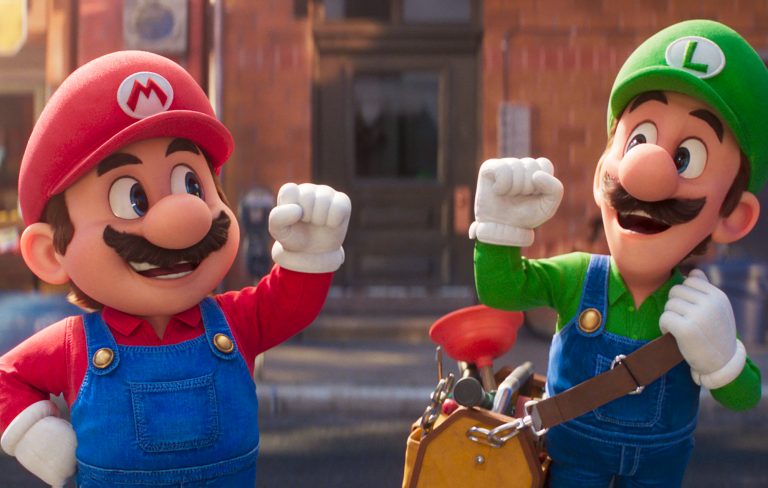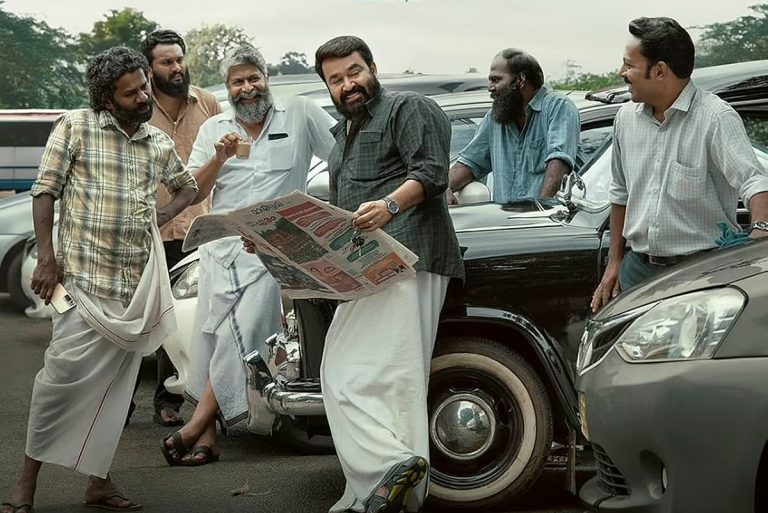Shin Kamen Rider (2023) Movie Review: The “Shin Japan Heroes Universe” comprises the movies Anno had been involved in either directorially or in the production and writing stages, containing four films that were all reimaginations of renowned science-fiction franchises in Japan. Unlike the current obsession with shared universes, this is more of a collaborative effort between the studios having the rights to all these projects, united by Anno’s love for these properties but not promising a universe crossover so much as a stylistic stamp through all of them.
“Shin Kamen Rider” begins in media res, with the titular character already on his trusty steed, the customized motorbike called Cyclone. Ruriko Midorikawa accompanies him and is being chased by agents of SHOCKER (Sustainable Happiness Organisation with Computational Knowledge Embedded Remodelling). The chase is characterized by Anno’s love for hyper-kinetic editing, very close zooms on the vehicles, and the feet of the combatants.
However, when Kamen Rider finally begins to delve into hand-to-hand combat, the berserker rage produced due to the “prana” in his belt causes him to become violent. It is quite evident in that sequence that Anno is enjoying the overall filmmaking of this entire endeavor if the squibs and the pools of blood produced after the combatants were beaten to death hadn’t been any indication.
“Shin Kamen Rider” then becomes a story of Takeshi Hongo and Ruriko Midorikawa’s efforts to take down SHOCKER and their current leader, the Butterfly-Aug, who is later revealed to be Ichiro Midorikawa, Ruriko’s sister. These are snippets extracted from the exposition dumps that occur in the script during the moments of reprieve in this overstuffed script.
Like “Shin Ultraman,” “Shin Kamen Rider” feels like a season’s worth of story stuffed into a two-hour narrative, and the inconsistency in the pacing reflects that. Shin Kamen Rider could also be considered the most inaccessible of all these reimaginings for any newcomer. As an absolute newcomer to the “Kamen Rider” mythos, all of these expositions and world-building are fascinating.
It is a lazy critical appraisal trope to compare the previous directorial effort to the current one. But considering how much of it is structurally and thematically similar, the storytelling itself is bound to create a comparison. Unlike Shin Ultraman, the text-dump exposition is discarded. The backstory in Shin Kamen Rider for the titular character is done via monochromatic flashbacks interspersed within the present-day narrative until the beginning of the final act, when government officials Taki and Tachibana finally inquire about his past. Structurally, Shin Kamen Rider feels very episodic. Nevertheless, the nature of the “episodes” feels very similar, and the storytelling eases into each episode very smoothly.
The depth and effort given to flesh out the relationship dynamics between Hongo and Ruriko stand out. It also plays into the trope of the tortured hero who wants to save and protect humanity and attain happiness, but always at the cost of emotional despair and loss. The chemistry between Ruriko and Hongo is strong for the viewer to buy into it, even though Anno’s propensity to create this as a love letter to the 1970s Television series extends to the dialogues. Characters voice their feelings and motivations with confidence and vigorous candor, but sincerity is at play here, which is always appreciated.
That sincerity morphs into the energy of the filmmaking and the retro stylization Anno and his team utilizes to craft this modern take. From the suit being a slight tweaking of the classic one to the fight styles being edited and choreographed like the traditional tokusatsu action choreography (lots of flipping over the heads, spinning jumps, and holding onto a flying kick, resembling a video game move), to even the CGI feeling and looking deliberately cheap, it is a very different stylistic approach to what viewers associate with in regards to superhero storytelling. The beauty of this pastiche is very moving.
Unlike Anno’s other ventures, there isn’t a focus on philosophical musings or deeper existential questions. The theme of happiness and the misconstruing of happiness by the artificial intelligence of SHOCKER to serve its ends of world dominance is interesting, but it never climaxes with any encompassing revelations. Anno is more interested in creating a new season of Kamen Rider, made with perhaps more panache and finesse in the imperfections than the source material it derives from. But to streamline the property for the ever-elusive new audiences, it focuses on camp sensibilities and tone rather than on details. That is a double-edged sword because it lends itself more to the subjectivity and reception of these new audiences.
From that perspective, while this writer has never been familiar with the “Kamen Rider” mythos, familiarity with the tokusatsu style of filmmaking is enough to enjoy the specific brand of flavor that Shin Kamen Rider is offering. It chooses to gloss over important details (how are these insect-human hybrids made?), but it succeeds enough in the emotional poignancy, translating the simplicity of the source material for the modern age.
At the very least, Shin Kamen Rider doesn’t skimp on the fact that the Cyclone and the helmet are cool designs. Or that two Kamen Riders are better than one (yes, there are two of them). Or that these characters call out their names and plan out team-up moves with imperceptible shakes of their heads. Iconography, by its definition, defies generations and the passage of time.
All of these movies in this universe can be reimagined, but the iconography will remain. However, if you are going to craft a love letter to this franchise, you can do worse than take the road traveled by Hideaki Anno.




![The Disaster Artist [2017]: Filling the Hollow](https://79468c92.delivery.rocketcdn.me/wp-content/uploads/2019/02/the-disaster-artist-768x432.jpg)




